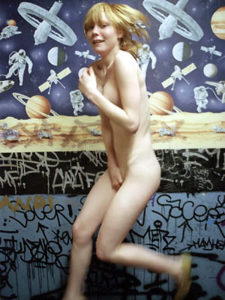In the Fifties and Sixties, slice-of-life photographers went in search of “real people” and “real places.” More often than not, “real” meant sordid, squalid, hardscrabble: old motels, carnival freaks, pimps, slum kids, drag queens, migrant workers, hippies, and anyone missing lots of teeth. The photographs were often good, but from a sociological point of view, they tended toward clichés and voyeurism.

“Lizzy” by Ryan McGinley.
In the Eighties and Nineties, some photographers discovered that their own lives looked pretty real, maybe even sordid and squalid. Robert Mapplethorpe focused on sadomasochistic gay sex. Nan Goldin, a former heroin addict, photographed her East Village demimonde in such series as “The Ballad of Sexual Dependency.”
Out of this tradition of confessional photography comes Ryan McGinley, 25, whose small show in the Whitney Museum’s “First Exposure” series portrays his own contemporary East Village crowd. They are not dissimilar to many of their bohemian predecessors, actually —but are interesting to us in the ways they seem slightly different, and because they are young and living this life here and now. The beats of the Fifties blazed new paths in literature and music. The last wave that came out of the East Village found itself in the middle of a plague. How will this cohort fare? McGinley seeks to reassure us, it seems, by the exhibit’s title, “The Kids Are Alright.” Their mothers might feel less certain. There are a lot of smiles and high spirits, to be sure, but the kids look a little undernourished. They sometimes look doped up or strung out, and in some of the sexual posturing, it’s hard not to remember that the last time you saw pictures like this, they were coupled with ones of people dying of AIDS.
McGinley grew up in Ramsey. While in high school, he met photographer Larry Clark, who was doing a documentary series on a group of Manhattan skateboard enthusiasts. Clark made his reputation with edgy and X-rated portraits of teenagers, including the movie “Kids,” a full-length feature about promiscuous and self-destructive teens. Clark’s subject matter seems to have made its mark on McGinley. Later, as a student at Parsons School of Design in Manhattan, he produced a 50-page book of photographs of his friends with the same title as this show.
McGinley works in color, and the prints are large — poster size. The subjects often look right back at the camera, some are obviously posed. A few are sleeping. Tattoos are evident, but not piercings, which appear to be passé. They’re not really kids, anymore, but act like they are, dressing in jeans, T-shirts, and cheap sneakers, riding bikes, and frolicking in the surf on trips to the beach. They pair up in all the variations, boy-boy, girl-girl, and boy-girl.
In one of the show’s best images, a young woman streaks naked past a graffiti-covered wall. She smiles at the camera but covers herself with her hands. The tension in the picture comes from the girl’s wholesomeness — she looks like a tomboyish farm girl running for the swimming hole —contrasted with the rude bands of graffiti on the lower wall behind her and the dark blue outer space posters that rather beautifully frame her head.
McGinley is at his best here and in other pictures that show a playful side. His photograph of himself in the midst of a root canal, his mouth crammed with dental apparatus, might qualify as one of photography’s most original self-portraits. Equally original is “BMX,” a severely cropped, overhead view of a bike rider, showing only the rider’s forearms and knees, the handlebars, and the small front wheel. Despite its minimalism, there are telling details: the tightly gripping hands, the tattooed arm, the jeans and sneakers, the heavy-duty bike lock, and the black pavement whizzing by beneath.
In several pictures, we see guys spraying graffiti on walls. One, showing the crouched sprayer on a rooftop, precariously perched and framed against the warm, brownish night sky, has an air of swashbuckling romance about it. But, from a sociological standpoint — graffiti? It’s back? As a bohemian affectation of middle-class white kids? Aren’t they a little old for this? Some of the sexual exhibitionism seems tired, too. And there are too many people who look wrecked, glassy-eyed, or wasted for a show that proclaims how “alright” everyone is — like the lost soul slumped in the corner of an elevator or the one with the nose bloodied from snorting something. And the one expectorating a stream of vomit.
In the end, what comes across strongly is how childlike these twentysomethings still are. The photographer has chosen to show them at play or at leisure, but do their lives have a serious side? The closest any picture comes to this is one of a sensitive-looking young man with a pen resting on his ear. But, then again, his pupils look rather enlarged.
Whitney Museum of American Art
2003

